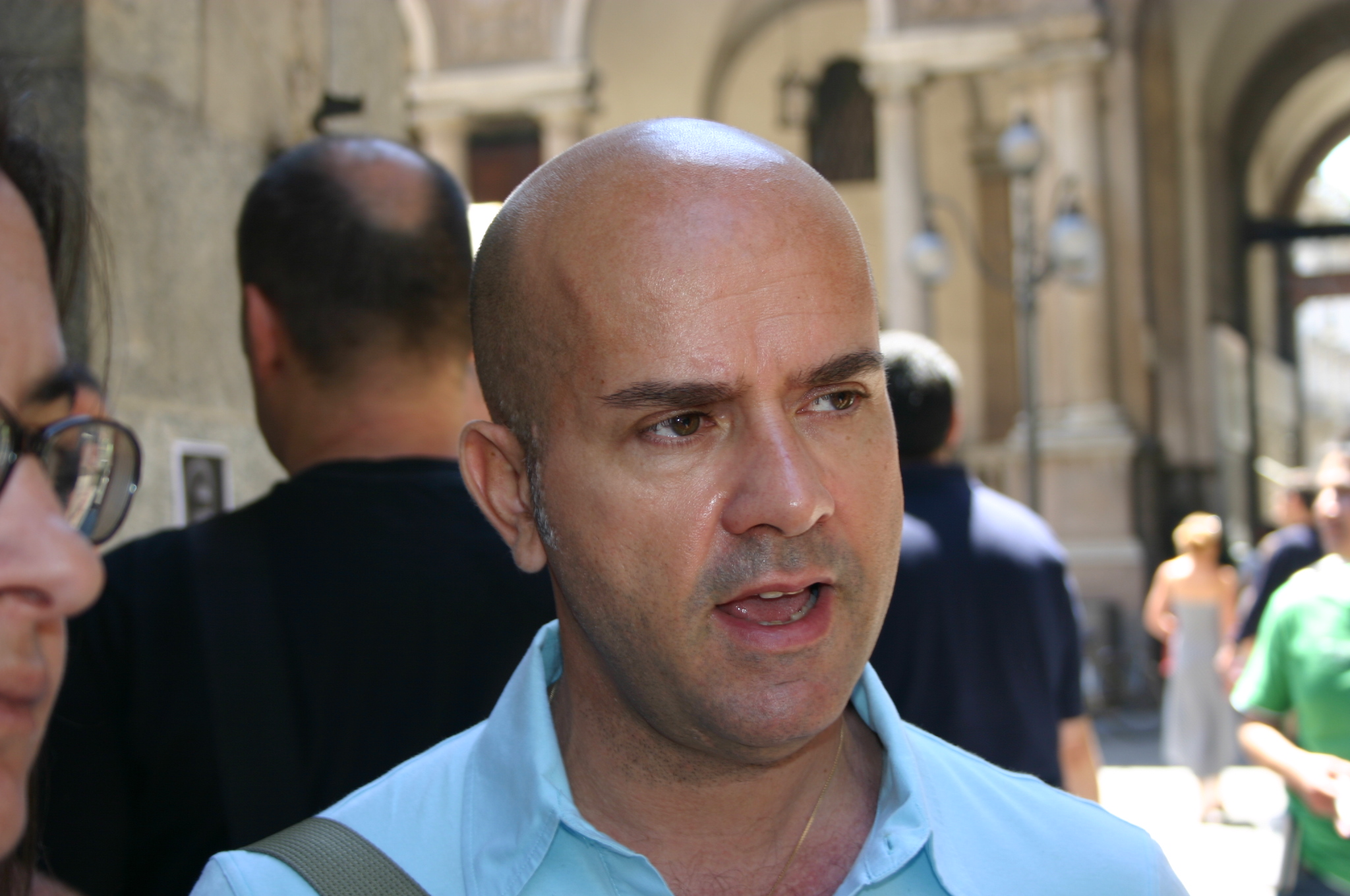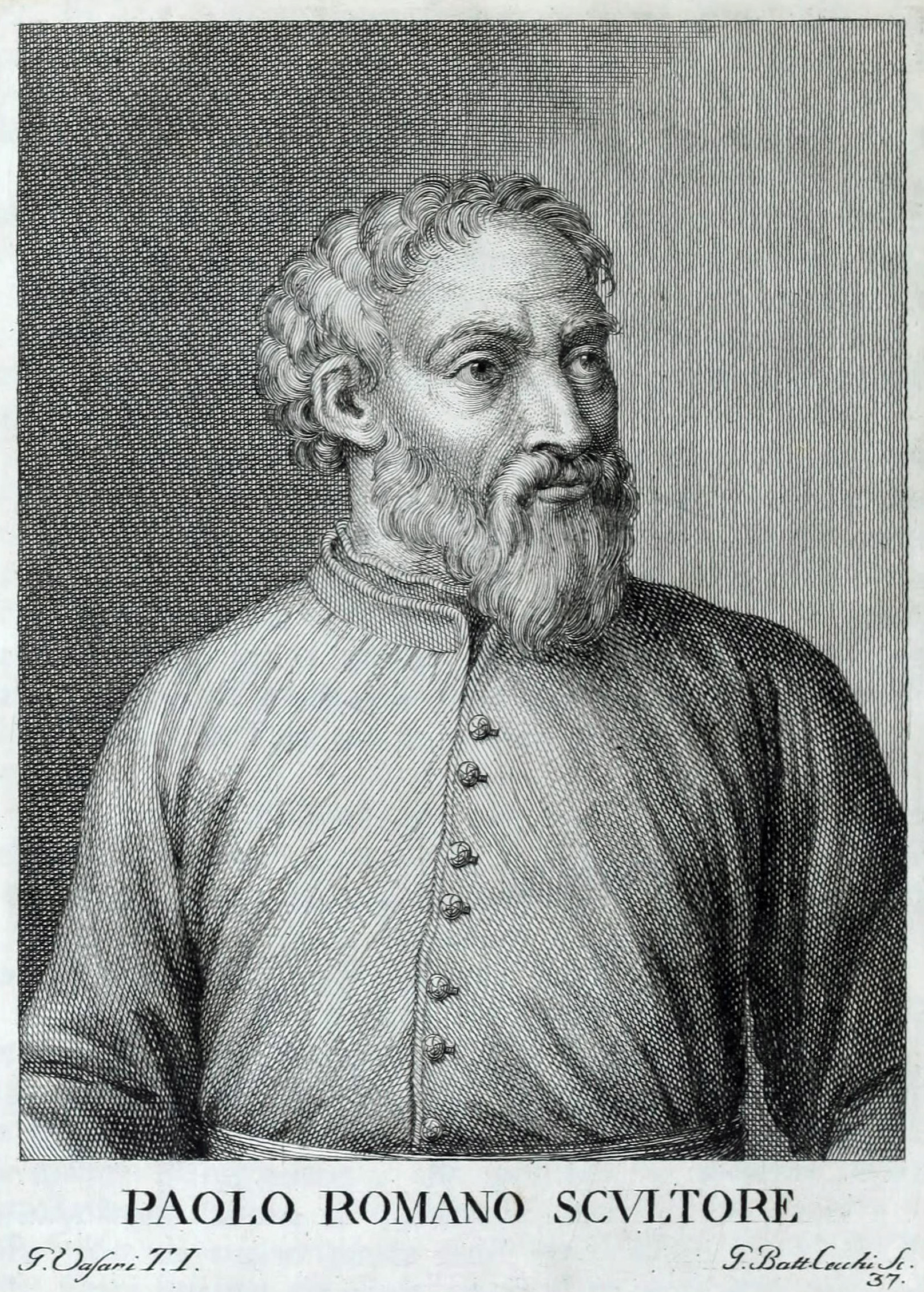|
Paolo (other)
Paolo is both a given name and a surname, the Italian form of the name Paul. Notable people with the name include: People with the given name Art *Paolo Abbate (1884–1973), Italian-American sculptor *Paolo Alboni (1671–1734), Italian painter *Paolo Antonio Barbieri (1603–1649), Italian painter *Paolo Buggiani (born 1933), Italian contemporary artist *Paolo Carosone (born 1941), Italian painter and sculptor *Paolo Moranda Cavazzola (1486–1522), Italian painter *Paolo Farinati (), Italian painter *Paolo Fiammingo (–1596), Flemish painter *Paolo Domenico Finoglia (–1645), Italian painter *Paolo Grilli (1857–1952), Italian sculptor and painter *Paolo de Matteis (1662–1728), Italian painter *Paolo Monaldi, Italian painter *Paolo Pagani (1655–1716), Italian painter *Paolo Persico (–1796), Italian sculptor *Paolo Pino (1534–1565), Italian painter *Paolo Gerolamo Piola (1666–1724), Italian painter *Paolo Porpora (1617–1673), Italian painter *Paolo Romano (died ) ... [...More Info...] [...Related Items...] OR: [Wikipedia] [Google] [Baidu] |
Italian Language
Italian (''italiano'' or ) is a Romance language of the Indo-European language family that evolved from the Vulgar Latin of the Roman Empire. Together with Sardinian, Italian is the least divergent language from Latin. Spoken by about 85 million people (2022), Italian is an official language in Italy, Switzerland (Ticino and the Grisons), San Marino, and Vatican City. It has an official minority status in western Istria (Croatia and Slovenia). Italian is also spoken by large immigrant and expatriate communities in the Americas and Australia.Ethnologue report for language code:ita (Italy) – Gordon, Raymond G., Jr. (ed.), 2005. Ethnologue: Languages of the World, Fifteenth edition. Dallas, Tex.: SIL International. Online version Itali ... [...More Info...] [...Related Items...] OR: [Wikipedia] [Google] [Baidu] |
Paolo Grilli
Paolo Grilli (3 August 1857 – 16 January 1952) was an Italian sculptor and painter. He was born in Cesena. In the early 1880s, he studied in the Academy of Fine Arts in Florence, and later in Rome. He returned to Cesena, where he was active in creating statues, busts and medallions for public and private commissions. He died in Rome. It is unclear what his relationship was to Paolo Grilli, also from Cesena, who was arrested, along with Paolo Tibaldi from Longo and Giuseppe Bartolotti from Bologna, on June 13, 1857, in Paris for a conspiracy to murder the Emperor Napoleon III of France. This conspiracy appears to have been hatched by or with the help of Giuseppe Mazzini, then in exile in London. This is about a year before the Orsini affair The Orsini affair comprised the diplomatic, political and legal consequences of the "Orsini attempt" (french: attentat d'Orsini): the attempt made on 14 January 1858 by Felice Orsini, with other Italian nationalists and backed by English r ... [...More Info...] [...Related Items...] OR: [Wikipedia] [Google] [Baidu] |
Paolo Veronese
Paolo Caliari (152819 April 1588), known as Paolo Veronese ( , also , ), was an Italian Renaissance painter based in Venice, known for extremely large history paintings of religion and mythology, such as ''The Wedding at Cana'' (1563) and ''The Feast in the House of Levi'' (1573). Included with Titian, a generation older, and Tintoretto, a decade senior, Veronese is one of the "great trio that dominated Venetian painting of the ''cinquecento''" and the Late Renaissance in the 16th century.Rosand, 107 Known as a supreme colorist, and after an early period with Mannerism, Paolo Veronese developed a naturalist style of painting, influenced by Titian. His most famous works are elaborate narrative cycles, executed in a dramatic and colorful style, full of majestic architectural settings and glittering pageantry. His large paintings of biblical feasts, crowded with figures, painted for the refectories of monasteries in Venice and Verona are especially famous, and he was also the leadi ... [...More Info...] [...Related Items...] OR: [Wikipedia] [Google] [Baidu] |
Paolo Veneziano
Paolo Veneziano, also Veneziano Paolo or Paolo da Venezia (active by 1333, died after 1358) was a 14th-century painter from Venice, the "founder of the Venetian School" of painting, probably active between about 1321 and 1362.Paolo Veneziano in: Federico Zeri, with the assistance of Elizabeth E. Gardner, ''Italian paintings : a catalogue of the collection of the Metropolitan Museum of Art : Venetian school'', p. 47-48 He has been called 'the most important of the 14th century'. His many signed and dated works, some in collaboration with his sons, range between 1333 and 1358. He was regarded as the official painter of the Venetian Republic. [...More Info...] [...Related Items...] OR: [Wikipedia] [Google] [Baidu] |
Paolo Uccello
Paolo Uccello ( , ; 1397 – 10 December 1475), born Paolo di Dono, was an Italians, Italian (Florentine) Florentine painting, painter and mathematician who was notable for his pioneering work on visual Perspective (graphical), perspective in art. In his book ''Lives of the Most Excellent Painters, Sculptors, and Architects'', Giorgio Vasari wrote that Uccello was obsessed by his interest in perspective and would stay up all night in his study trying to grasp the exact vanishing point. While his contemporaries used perspective to narrate different or succeeding stories, Uccello used perspective to create a feeling of depth in his paintings. His best known works are the The Battle of San Romano, three paintings representing the battle of San Romano, which were wrongly entitled the ''Battle of Sant'Egidio of 1416'' for a long period of time. Paolo worked in the International Gothic, Late Gothic tradition, emphasizing colour and pageantry rather than the classical realism that other a ... [...More Info...] [...Related Items...] OR: [Wikipedia] [Google] [Baidu] |
Paolo Schmidlin
Paolo Schmidlin (born 1964 in Milan) is an Italian sculptor. A graduate from the Brera Academy, Schmidlin lives and works in Milan. Schmidlin's work has courted controversy and censorship, particularly ''Miss Kitty'', a depiction of Pope Benedict XVI partially clothed and wearing women's underwear. The piece was supposed to be part of an exhibition in Italy at a 2007 gay pride event in Milan, but was removed from display. It had gained the attention of the Catholic Anti-Defamation League who called it "a vulgar offence" and threatened legal action if it featured in the event. Schmidlin's portfolio also includes a depiction of Marilyn Monroe Marilyn Monroe (; born Norma Jeane Mortenson; 1 June 1926 4 August 1962) was an American actress. Famous for playing comedic " blonde bombshell" characters, she became one of the most popular sex symbols of the 1950s and early 1960s, as wel ... on her deathbed, a photograph of which has been mistaken as a true image of Monroe. Referenc ... [...More Info...] [...Related Items...] OR: [Wikipedia] [Google] [Baidu] |
Paolo Sarti
Paolo Sarti (born in late 1700s, in Florence) was an Italian painter. Biography He mainly painted frescoes, including one in the ceiling (1838) of the ''Sala degli Esperimenti'' (Hall of Experiments) in the Collegio di San Giovannino, found adjacent to the Church of San Giovannino degli Scolopi, Florence. The fresco depicts ''Christian religion reveals science''. Sarti also painted the sipario (theater curtain) of the Teatro della Piazza Vecchia. He depicted ''Dante legge l'episodio di Francesca da Rimini alla corte di Guido da Polenta'' (Dante reads the episode of Francesca da Rimini before the Court of Guido II da Polenta Guido II da Polenta (died 1330), also known as Guido Novello, was an Italian who served as lord of Ravenna from 1316 until 1322. The nephew of Lamberto I da Polenta, he acquired the lordship of the city after the latter's death. In 1316–1321 h ...). Pietro Baldancoli was a pupil of Sarti. References 19th-century Italian painters Italian male pain ... [...More Info...] [...Related Items...] OR: [Wikipedia] [Google] [Baidu] |
Paolo Romano
Paolo Romano, also known as Paolo Tuccone and as Paolo di Mariano di Tuccio Taccone was an Italian Renaissance sculptor and goldsmith. He was active by 1451, and probably died by 1470.Getty ULAN Giorgio Vasari in his '' Lives of the Most Excellent Painters, Sculptors, and Architects'' recounts that Paolo Romano was a modest man whose sculpture was far superior to that of his boastful contemporary Mino del Reame. The Vatican Museums and the church of Sant'Andrea della Valle in Rome are home to sculptures by Paolo Romano. His disciples include Giovanni Cristoforo Romano. References * Bessone-Aurelj, A.M., ''Dizionario degli scultori ed architetti italiani'', Genova, Società anonima editrice D. Alighieri, 1947. * ''Encyclopedia of World Art'', New York, McGraw-Hill, 1959–1987. * Seymour, Charles, ''Sculpture in Italy, 1400-1500'', Baltimore, Maryland, Penguin, 1968. * Thieme, Ulrich and Felix Becker, editors, ''Allgemeines Lexikon der bildenden Künstler von der Antike b ... [...More Info...] [...Related Items...] OR: [Wikipedia] [Google] [Baidu] |
Paolo Porpora
Paolo Porpora (1617–1673) was an Italian painter of the late-Baroque, who was active mainly in Naples and specialized in floral still lifes. He is documented as a pupil of Giacomo Recco, the father of Giuseppe Recco, and said to have worked under Aniello Falcone. He joined the Roman Accademia di San Luca from 1656 to 1658. He appears to have been influenced in Rome by Netherlandish still-life painters. Among his pupils were Giovan Battista Ruoppolo and the Neapolitan Onofrio Loth Onofrio is an Italian surname derived from Onuphrius. Notable people with the surname include: *Vincent D'Onofrio *Al Onofrio *Beverly Donofrio *Elizabeth D'Onofrio *Francesco Onofrio Manfredini *Marco Onofrio See also *Sant'Onofrio (disambiguatio ... (died 1717).* Sources Web Gallery of Art Biography 1617 births 1670 deaths 17th-century Neapolitan people 17th-century Italian painters Italian male painters Painters from Naples Italian Baroque painters Italian still life painters ... [...More Info...] [...Related Items...] OR: [Wikipedia] [Google] [Baidu] |
Paolo Gerolamo Piola
Paolo Gerolamo Piola (1666–1724) was an Italian painter of the Baroque period active mainly in Genoa. His father was the prominent Genoese painter Domenico Piola. Paolo Gerolamo was very active painting sacred subjects and frescoes. He was sent to study in Rome by his father, where he supposedly studied the work of Caracci, and studied under Carlo Maratta. Returning to Genoa, his father found his style ponderous. He was ultimately praised for his designs, and canvases for the church of Santa Maria di Carignano Santa Maria Assunta is a Renaissance church in Genoa, Italy. It is located in a residential sector called Carignano located on the hills just above the city center, thus the church is also known as ''Santa Maria Assunta di Carignano''. Structure a .... References 1666 births 1724 deaths 17th-century Italian painters Italian male painters 18th-century Italian painters Painters from Genoa Italian Baroque painters 18th-century Italian male artists {{It ... [...More Info...] [...Related Items...] OR: [Wikipedia] [Google] [Baidu] |
Paolo Pino
Paolo Pino (1534–1565) was an Italian painter and art writer. He was born in Venice. A student of Giovanni Gerolamo Savoldo, he wrote the "Dialogo di pittura" (1548), which affirmed the supremacy of the Venetian School (art), Venetian School over the Florentine School and anticipated some aspects of the Mannerism, Mannerist style. Works Writings * Paintings *''Portrait of a collector'', Musée des Beaux-Arts de Chambéry, Musée des Beaux-Arts, Chambéry, France. ''Portrait of Doctor Coignati'' 1534, Uffizi Sources Bibl. : Gilbert Creighton, « Antique Framework for Renaissance Art Theory : Alberti and Pino », Marsyas 3 (1946). 1534 births 1565 deaths 16th-century Italian painters Italian male painters Painters from Venice Italian male non-fiction writers Italian art historians Artist authors {{Italy-art-historian-stub ... [...More Info...] [...Related Items...] OR: [Wikipedia] [Google] [Baidu] |
Paolo Persico
Paolo Persico (1796), was an Italian sculptor of the late-Baroque, active at and near Naples. He is best known for sculptures in the gardens of Palace of Caserta, including the figures of ''Diana and Acteon'' in a fountain. He also contributed statues of the ''Lions'' for the entrance stairway, a ''Faun'', ''The Gladiator'', and an ''Apollo''. His work at Caserta was a collaborative project with contributions by Angelo Brunelli, Pietro Solari, Andrea Violani, and Gaetano Salomone. by Pietro Napoli-Signorelli. Volume II, 2nd edition, Naples (1811); page 252. He also produced sculptures, including the statuary group called ''Soavità del giogo matrimoniale'' and the angels in the complex bas-relief of the main altarpiece depicting the ''Deposition'' (collaboration with Francesco Cele ... [...More Info...] [...Related Items...] OR: [Wikipedia] [Google] [Baidu] |






_-_BEIC_6362186.jpg)